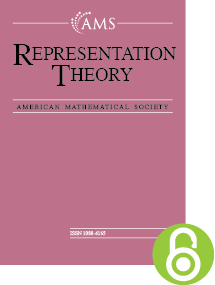Resonances for the Laplacian on Riemannian symmetric spaces: The case of $\mathrm {SL}(3,\mathbb {R})/\mathrm {SO}(3)$
HTML articles powered by AMS MathViewer
- by J. Hilgert, A. Pasquale and T. Przebinda
- Represent. Theory 21 (2017), 416-457
- DOI: https://doi.org/10.1090/ert/506
- Published electronically: October 11, 2017
- PDF | Request permission
Abstract:
We show that the resolvent of the Laplacian on $\mathrm {SL}(3,\mathbb {R})/\mathrm {SO}(3)$ can be lifted to a meromorphic function on a Riemann surface which is a branched covering of $\mathbb C$. The poles of this function are called the resonances of the Laplacian. We determine all resonances and show that the corresponding residue operators are given by convolution with spherical functions parameterized by the resonances. The ranges of these operators are infinite dimensional irreducible $\mathrm {SL}(3,\mathbb {R})$-representations. We determine their Langlands parameters and wave front sets. Also, we show that precisely one of these representations is unitarizable. Alternatively, they are given by the differential equations which determine the image of the Poisson transform associated with the resonance.References
- David H. Collingwood and William M. McGovern, Nilpotent orbits in semisimple Lie algebras, Van Nostrand Reinhold Mathematics Series, Van Nostrand Reinhold Co., New York, 1993. MR 1251060
- Ramesh Gangolli and V. S. Varadarajan, Harmonic analysis of spherical functions on real reductive groups, Ergebnisse der Mathematik und ihrer Grenzgebiete [Results in Mathematics and Related Areas], vol. 101, Springer-Verlag, Berlin, 1988. MR 954385, DOI 10.1007/978-3-642-72956-0
- Colin Guillarmou, Resonances and scattering poles on asymptotically hyperbolic manifolds, Math. Res. Lett. 12 (2005), no. 1, 103–119. MR 2122734, DOI 10.4310/MRL.2005.v12.n1.a10
- Laurent Guillopé and Maciej Zworski, Polynomial bounds on the number of resonances for some complete spaces of constant negative curvature near infinity, Asymptotic Anal. 11 (1995), no. 1, 1–22. MR 1344252, DOI 10.3233/ASY-1995-11101
- Sigurdur Helgason, Groups and geometric analysis, Pure and Applied Mathematics, vol. 113, Academic Press, Inc., Orlando, FL, 1984. Integral geometry, invariant differential operators, and spherical functions. MR 754767
- Sigurdur Helgason, Geometric Analysis on Symmetric Spaces. Second edition, American Mathematical Society, Providence, 2008.
- J. Hilgert and A. Pasquale, Resonances and residue operators for symmetric spaces of rank one, J. Math. Pures Appl. (9) 91 (2009), no. 5, 495–507 (English, with English and French summaries). MR 2517785, DOI 10.1016/j.matpur.2009.01.009
- P. D. Hislop and I. M. Sigal, Introduction to spectral theory, Applied Mathematical Sciences, vol. 113, Springer-Verlag, New York, 1996. With applications to Schrödinger operators. MR 1361167, DOI 10.1007/978-1-4612-0741-2
- Jay Jorgenson and Serge Lang, Spherical inversion on SL${_n}(\textbf {R})$, Springer Monographs in Mathematics, Springer-Verlag, New York, 2001. MR 1834111, DOI 10.1007/978-1-4684-9302-3
- Anthony W. Knapp, Representation theory of semisimple groups, Princeton Mathematical Series, vol. 36, Princeton University Press, Princeton, NJ, 1986. An overview based on examples. MR 855239, DOI 10.1515/9781400883974
- Rafe Mazzeo and András Vasy, Analytic continuation of the resolvent of the Laplacian on $\rm SL(3)/SO(3)$, Amer. J. Math. 126 (2004), no. 4, 821–844. MR 2075483, DOI 10.1353/ajm.2004.0031
- Rafe Mazzeo and András Vasy, Analytic continuation of the resolvent of the Laplacian on symmetric spaces of noncompact type, J. Funct. Anal. 228 (2005), no. 2, 311–368. MR 2175410, DOI 10.1016/j.jfa.2004.10.003
- Rafe Mazzeo and András Vasy, Scattering theory on $\textrm {SL}(3)/\textrm {SO}(3)$: connections with quantum 3-body scattering, Proc. Lond. Math. Soc. (3) 94 (2007), no. 3, 545–593. MR 2325313, DOI 10.1112/plms/pdl004
- Richard B. Melrose, Geometric scattering theory, Stanford Lectures, Cambridge University Press, Cambridge, 1995. MR 1350074
- R. J. Miatello and C. E. Will, The residues of the resolvent on Damek-Ricci spaces, Proc. Amer. Math. Soc. 128 (2000), no. 4, 1221–1229. MR 1695119, DOI 10.1090/S0002-9939-99-05498-2
- Toshio Oshima and Nobukazu Shimeno, Boundary value problems on Riemannian symmetric spaces of the noncompact type, Lie groups: structure, actions, and representations, Progr. Math., vol. 306, Birkhäuser/Springer, New York, 2013, pp. 273–308. MR 3186696, DOI 10.1007/978-1-4614-7193-6_{1}3
- A. M. Perelomov, Integrable systems of classical mechanics and Lie algebras. Vol. I, Birkhäuser Verlag, Basel, 1990. Translated from the Russian by A. G. Reyman [A. G. Reĭman]. MR 1048350, DOI 10.1007/978-3-0348-9257-5
- W. Rossmann, Picard-Lefschetz theory and characters of a semisimple Lie group, Invent. Math. 121 (1995), no. 3, 579–611. MR 1353309, DOI 10.1007/BF01884312
- Barry Simon, Resonances in $n$-body quantum systems with dilatation analytic potentials and the foundations of time-dependent perturbation theory, Ann. of Math. (2) 97 (1973), 247–274. MR 353896, DOI 10.2307/1970847
- Birgit Speh, The unitary dual of $\textrm {Gl}(3,\,\textbf {R})$ and $\textrm {Gl}(4,\,\textbf {R})$, Math. Ann. 258 (1981/82), no. 2, 113–133. MR 641819, DOI 10.1007/BF01450529
- Alexander Strohmaier, Analytic continuation of resolvent kernels on noncompact symmetric spaces, Math. Z. 250 (2005), no. 2, 411–425. MR 2178792, DOI 10.1007/s00209-004-0760-y
- David A. Vogan Jr., Representations of real reductive Lie groups, Progress in Mathematics, vol. 15, Birkhäuser, Boston, Mass., 1981. MR 632407
- Maciej Zworski, Resonances in physics and geometry, Notices Amer. Math. Soc. 46 (1999), no. 3, 319–328. MR 1668841
- M. Zworski, What are the residues of the resolvent of the Laplacian on non-compact symmetric spaces?, Seminar held at the IRTG-Summer School 2006, Schloss Reisensburg, 2006. Available at http://math.berkeley.edu/$\sim$zworski/reisensburg.pdf
Bibliographic Information
- J. Hilgert
- Affiliation: Department of Mathematics, Paderborn University, Warburger Str. 100, D-33098 Paderborn, Germany
- Email: hilgert@math.uni-paderborn.de
- A. Pasquale
- Affiliation: Université de Lorraine, Institut Elie Cartan de Lorraine, UMR CNRS 7502, Metz, F-57045, France
- MR Author ID: 337961
- Email: angela.pasquale@univ-lorraine.fr
- T. Przebinda
- Affiliation: Department of Mathematics, University of Oklahoma, Norman, OK 73019, USA
- MR Author ID: 257122
- Email: tprzebinda@ou.edu
- Received by editor(s): October 13, 2016
- Received by editor(s) in revised form: August 28, 2017
- Published electronically: October 11, 2017
- Additional Notes: The first and second author would like to thank the University of Oklahoma for their hospitality and financial support. The third author gratefully acknowledges hospitality and financial support from the Université de Lorraine and partial support from the NSA grant H98230-13-1-0205.
- © Copyright 2017 American Mathematical Society
- Journal: Represent. Theory 21 (2017), 416-457
- MSC (2010): Primary 43A85; Secondary 58J50, 22E30
- DOI: https://doi.org/10.1090/ert/506
- MathSciNet review: 3710652


